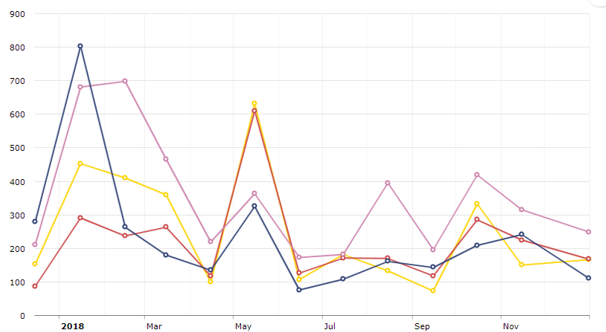Overview
eResources usage statisticsAbout e-resources usage statistics and how to interpret them.
Find out about the terms used in usage statistics, the reports available to you, and how to determine the cost effectiveness of e-resources.

COUNTER
COUNTER reports are standard and therefore can be used reliable comparisons between the same types of electronic resources from different suppliers.
See also COUNTER 5 for Librarians.
They cover usage at platform, database, title and item level. Click the expanders below to find out more.
Metrics
COUNTER 5 introduces new metrics grouped into:
- investigations: when a user clicks on parts of a record, for example viewing the abstract, requesting articles via ILL, or downloading the fulltext
- requests: when a user views or downloads full-text
COUNTER totals requests andinvestigations at title and item level. It also totals the number of searches being run on databases.
Totals and unique totals
When a user wants to search a database, they log into the platform, run their search(es), check out some results, perhaps download some articles, and then log out once they're finished.
If we think about a set of database results, the user may investigate a result record; they view the abstract, export the citation details and preview the article. They may also open the HTML full-text and download the PDF.
However, although the user is doing all sorts of investigations, it's the same record. So while the total adds up each separate investigation, it's one unique investigation - the user has investigated only the one record.
In this case, the user has perfomed five investigations but one unique investigation. In a similar way, they have requested the item twice, but it's for the same article, so it counts as one unique request.
Searches
Databases searches are also counted, but are split into different types, depending on how the search request is received by the database. Searches are counted at the platform and database level.
See the glossary for more information about the different COUNTER 5 metrics.
Reports
Platform, database, title and item reports are available and can now be filtered.These reports are the most useful:
- Platform usage: total and unique item requests, as well as platform searches. A platform is a supplier’s interface for searching resources, e.g. EBSCOhost, EDS, or BMJ Best Practice.
- Database search and item usage: total item investigations and requests, as well as searches.
- Database / journal / book access denied: shows where users were denied access to databases.
- Book requests / journal requests: fulltext activity for non Gold Open Access e-books /e-journals.
- Title usage: access denials to e-books / e-journals.
- Book usage by access type: / journal usage by access type: investigations and requests for e-books or e-journals.
Supplier reports
For help see EBSCO, ProQuest, BMJ Journals, Ovid).
As well as the COUNTER reports, suppliers may offer reports which allow for customization or give more detail. Some useful examples are:
Database usage: sessions, searches, and requests logged for each databases.
Interface usage: the interfaces, such as discovery, from which a search of databases was conducted.
Title usage: request for content for each title in the collections purchased.
What data does NHSE use?
NHS England has 5 dashboards in Tableau covering usage statistics for the following e-resources and metrics:
- Hub Total Requests
- BMJBP Page Impressions
- OpenAthens Account Usage
- LibKey Total Requests
- Royal Marsden Manual Item Requests
These allow Trusts to compare usage statistics with similar organisations.
NHS Knowledge and Library Hub
NHSE monitors usage through the EBSCO standard usage reports: interface usage; login usage; link activity.
The interface usage and login usage reports will be used to report on volume of use and the link activity report will be used to report on the number of ILL requests.
ThirdIron will also report on full-text requests via LibKey and BrowZine web.
BMJ Best Practice
Sessions and page impressions (website) / screen views (app).
Databases
Supplier-provided COUNTER 5 regular and automated searches, and unique item investigations.
E-journals and e-books
Supplier-provided COUNTER 5 unique item requests and unique title requests.
We aim to publish this data, suitably anonymised, in a dashboard to enable benchmarking by size of Trust.
INCDocs
INCDocs reports list request totals made by your organisation and requested from your organisations from other libraries.
Dashboards
NHSE provides e-resources usage statistics dashboards in Tableau for access by NHS KLS managers and staff responsible for electronic resources. The dashboards cover:
- NHS Library and Knowledge Hub total requests
- BMJ Best Practice page impressions
- OpenAthens account totals and usage
- LibKey total requests
- Royal Marsden Manual total item requests
Request access to Tableau via the Service Desk. See also How to access and use the e-Resources usage and national statistics dashboards on Tableau.
Page last reviewed: 15 June 2021